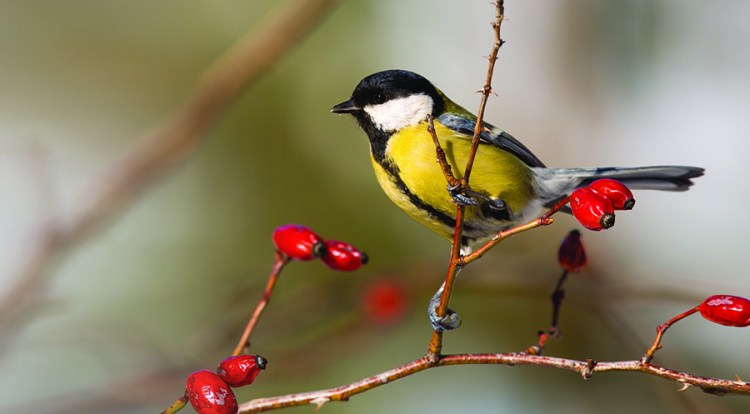In much of North America, winter can be a difficult time. The days are short, and nights are often cold and long. The natural food supply has been consumed or is hidden by snow. Most insects are dead or dormant. Water can be hard to find, and food for the energy to keep warm might be scarce. Leaves have fallen, building materials have been picked over—finding shelter may not be easy.
Brrrrr! Did that make you feel cold? Imagine being a little bird. Whether you’ve been hosting a backyard oasis for years or want to join the neighborhood network of bird rest stops, this guide will help you be “seasonally savvy” and support your avian neighbors in autumn as they prepare for a tough winter.

Shutterstock
PREPARE BIRD BATHS Water is the single most attractive element for birds, especially in the winter. Wild Birds Unlimited encourages all backyard-havers to provide an open source of water for birds by using a heater for your existing bird bath, or upgrading to a heated bath for year-round use.
Ceramic bird baths can crack under heavy ice and should be drained and covered in the winter, though some products can be kept out year-round if the proper de-icers are used. Check with your Wild Birds Unlimited sales associate or the manufacturer about the best kind of products to use in existing bird baths and ponds.
PREPARE SHELTER Place roosting boxes out for owls, woodpeckers, flickers, and other birds that might stay all winter in your area. Cleaning out old nests from existing bird houses can help reduce the possibility of parasitic bugs surviving the winter. It also allows birds the opportunity to roost in a clean house.
Plant cover can protect birds from cold weather and predators, including birds of prey or house cats (which should be kept indoors year-round!)

Shutterstock
PREPARE FEEDERS You will have more visitors in the fall as birds begin to cache their favorite foods for late winter resources. Clean the ground under or around feeders before it freezes or muds over. It also helps keep the mess down for birds that are feeding on the ground. See sidebar for steps on how to clean your feeders.
Autumn is a great time to check the feeder’s mounting hardware for stability and function, tightening screws and oiling joints. Paint scratched poles with rustproof spray enamel before the cold and wet weather sets in. If possible, feeders should be moved out of the wind for the winter. The east or southeast side of a house or near a row of trees is ideal. The feeders should be positioned near cover but in the open to allow birds to watch for danger. For ground feeding, an area near cover with a clear view of the surroundings is also desirable.
CHANGING THE MENU As winter approaches, many birds change some of their eating habits, so you’ll want to change what you are offering. Providing high calorie and high fat foods can be important to the birds. To keep up their high metabolic rate, most backyard birds eat rich, energy foods such as seeds, insects and suet. Oil sunflower is a great overall seed to offer in the winter.
Oil sunflower has twice the calories per pound than striped sunflower and its smaller shells make less mess when discarded by the birds.
Suet is a high energy, pure fat substance which is invaluable in winter when insects are harder to find and birds need many more calories to keep their bodies warm. It can be fed in a suet cage or a feeder that offers protection from the weather elements, attracting birds that can hang upside down.
Peanuts have high protein and fat levels and are often an ingredient in suet products. Try a peanut feeder on the Wild Birds Unlimited Advanced Pole System, but make sure you include a squirrel baffle.
CLEANING YOUR FEEDERS
Fastidious little creatures that they are, birds are more attracted to a clean and tidy feeding environment. Cleaning your feeders will help them look better and last longer, and it decreases the possibility of spreading sickness and disease among your fine-feathered friends.
Supplies needed
• Gloves
• Tubs/containers
• Dish soap
• Tube feeder brush
• Scrub brush
• Rag
• For deep cleaning: regular household bleach and measuring cup
Cleaning steps
1) Discard old food and debris from the feeder
2) Fill a utility sink or washtub/container with warm water and some dish soap
a) For a deep clean: Fill a utility sink or washtub/container with nine parts warm water to one part bleach
b) Soak feeder for a few minutes rotating it to submerge all parts
3) Thoroughly scrub the feeder with brushes or rags
4) Thoroughly rinse all parts
5) Let the feeder dry completely
6) Refill with fresh food, always just enough to last one or two days to avoid spoiling

Comments are not available on this story.
Send questions/comments to the editors.


